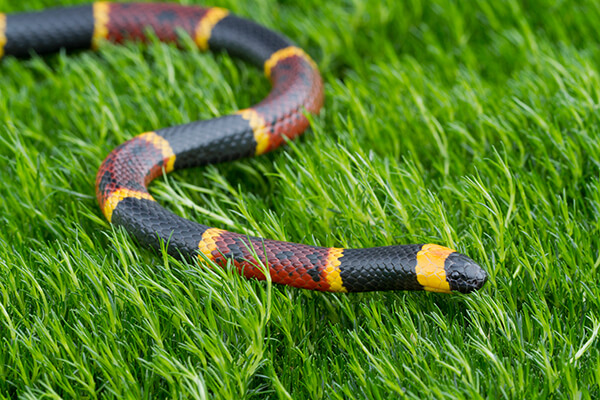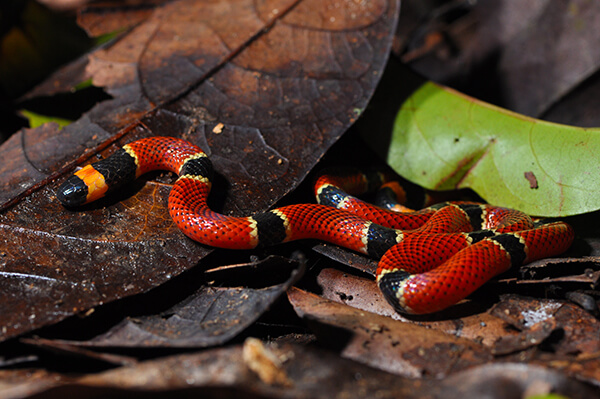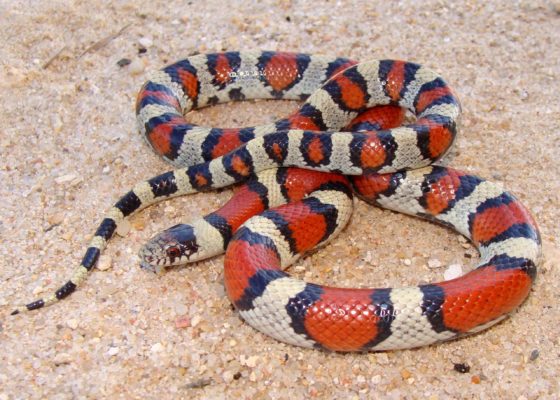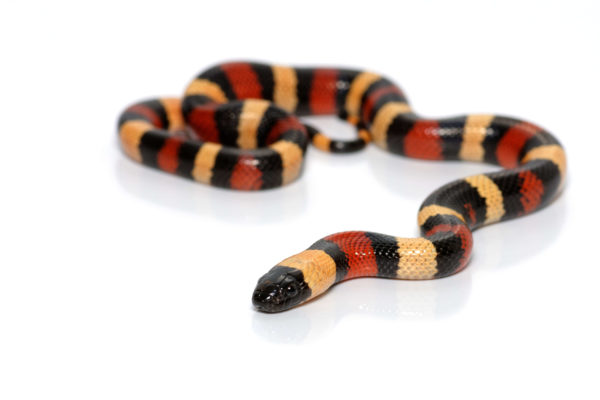
| Kingdom | Animalia |
| Phylum | Chordata |
| Class | Reptilia |
| Order | Squamata |
| Family | Elapidae |
| Genus | Leptomicurus, Micruroides, Micrurus, Calliophis, Hemibungarus, Sinomicrurs |
| Species | 81+ species |
| Niche | Predatory venomous snake |
| Length | 36 in (91 cm) – Average |
| Lifespan | 7 years |
| Social Structure | Reclusive |
| Conservation Status | Data Deficient for most species |
| Average Brood Size | 2-7 eggs |
| Main Prey Species | Small snakes, rodents, lizards, frogs, and birds. |
| Predators | Birds of prey, larger snakes, and mammals. |
The Basics
The Coral snake refers to venomous snakes of the family Elapidae, comprised of six genera and at least eighty-one distinct species. These are generally divided into two groups: New World coral snakes (Leptomicrurus, Micruroides, Micrurus) and Old World coral snakes (Calliophis, Hemibungarus, Sinomicrurus). There are over 65 known species of New World coral snakes and 16 Old World species.
In North America, coral snakes have notable color bands of red, yellow, white, and black. This includes the Eastern or Common coral snake (Micrurus fulvius), the Texas coral snake (Micrurus tener), and the Arizona coral snake (Micruroides euryxanthus), all found in the southwestern United States. In other parts of the world, these bands may be pink, blue, white, or black, depending on the species. In fact, some Old World species are not banded at all and instead are one solid color.
Sizing varies, but most species are fairly small. North American species average about 36 in (91 cm) with occasional specimens as long as 59 in (150 cm) being reported. In captivity, their lifespan is typically about 7 years.

Diverse and Reclusive
As there are so many species of coral snakes, their behavior varies widely. However, most species are rather elusive and many burrow underground or spend much of their time among leaf litter on the forest floor. In contrast, some species such as the Aquatic coral snake (Micrurus surinamensis) of South America spend most of their time in slow-moving waters among aquatic plants.
Prey species vary as well, but coral snakes will eat small mammals, amphibians, birds, and even other snake species. They boast a set of two small, hollow fangs at the front of their mouth that they use to deliver venom to their prey.
Coral snakes lay about 2-7 eggs, depending on the species, but due to their elusive nature, little is known about their mating and nesting habits.
In the new world, they are among the most poisonous snakes. Bites require immediate attention due to the venom’s powerful neurotoxins that can paralyze the breathing muscle. Due to their reclusive nature and remote habitat preferences, they are not likely to bite humans.
Fun Facts about Coral Snakes!
With so many species of coral snakes in the world, they allow for the exploration of seemingly endless fascinating biological concepts such as mimicry.

Looks That Could Kill
Coral snakes are venomous snakes. Like many other venomous or poisonous animals, they use bright coloring as if to warn other animals not to come too close. Interestingly, there are many examples of animals that may mimic the coloration of these animals, despite not having the same defenses.
There are a few forms of mimicry in the animal kingdom. In Batesian mimicry, an undefended species evolve to mimic another as it allows them to avoid being eaten by predators that have learned to avoid animals that appear like them. The Scarlet kingsnake (Lampropeltis elapsoides) closely mimics the coral snake. It is not poisonous but benefits from being associated with the more dangerous coral snake.

Humans, for example, have developed various riddles to try to decipher the difference in a pinch. For example, “Yellow on Black is a friend of Jack, red on yellow will kill a fellow“, referring to the order of the color bands on the animals. Unsurprisingly, the reliability of these strategies has been highly questioned.
With so many species of coral snakes, and up to 150 mimic species, would you rely on this riddle in dealing with a potentially venomous snake?
Tail, Scale, and Fin
Animals evolve by the phenomenon of natural selection, which allows for the passing down through generations of adaptations that give them a survival advantage. When a chance mutation occurs that allows the animal to become more successful in its environment, that trait gets passed on to the next generation and so on.
For example, some species of coral snakes that live in the water have evolved flat tails that act as fins. This allows them to swim much more effectively than their terrestrial cousins would be able to with their thin, pointy tails.

Origins in the Orient
Although the New World species seem to gain most of the attention, it is actually the Old World species have come first. In fact, genetic studies have determined that the most ancient lineages of coral snakes come from Asia. Some extant Asian species are colored quite differently than their New World counterparts, including some with solid coloration rather than banded patterns.
